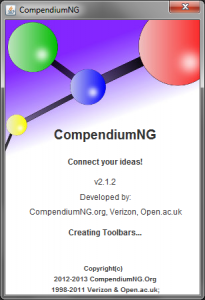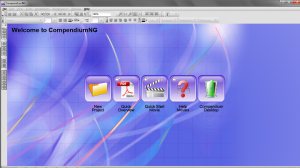 Compendium is an open source concept mapping tool I discovered when I was exploring design, looking into conflict resolution and complex problem solving in general, and I learned of Horst Rittel’s “Wicked Problems.” Compendium contains an icon set and database support for its “Issue-Based Information System (IBIS)”
Compendium is an open source concept mapping tool I discovered when I was exploring design, looking into conflict resolution and complex problem solving in general, and I learned of Horst Rittel’s “Wicked Problems.” Compendium contains an icon set and database support for its “Issue-Based Information System (IBIS)”
IBIS employs argument mapping that is designed to find solutions to wicked problems.

The new Compendium has an attractive background and new icons.
In argument mapping you simply pose a question and list the pros and cons , but you also connect dots and from there, in theory, the discussion takes off, aided by the visualization, which evolves in real time to reflect the process. Paul Culmsee has demonstrated how framing “powerful questions” can expedite this.
Mind mapping seems to tap our brain’s need for visual cues. Compendium makes it quick and easy to create maps, link and rearrange the bubbles, but that’s just the tip of the iceberg—you can add your own icons and icon (“stencil”) sets. It has tags, categories, a powerful database and metadata abilities behind it that could be accessed by other programs. It supports a high level of collaboration. You can attach files and external links to the bubbles, even create an interactive Web page that retains those links and attachments so you can share them on the Web. One version of Compendium, “CompendiumLD,” has been adapted to Learning Design. In my readings I’ve seen Compendium and other mind mapping tools used to design units, deliver lessons, as the focus, outcome or product of a lesson, and as a record of program implementation or student achievement used to assess the program or give the learner a grade. Compendium is also free and open source.
CompendiumNG appears to be more than just a facelift. But in a world where increasingly we expect to open a Web browser and go straight to engaging content, is a modernized interface and potential limited only by the imagination enough to motivate busy educators to adopt and learn, deeply, a complex new program? I have my doubts, and I believe a browser-based HTML5 mind mapping tool is not too far down the road. But when it comes to making thinking visible, I for one can’t wait. CompendiumNG is a “show and tell” tool, and that was always one of my favorite things to do at school.
§
Further reading, information
Culmsee, Paul (2013) A video about “powerful questions”, live mapping with Compendium.
Kirschner, Paul A. , Buckingham Shum, Simon J., and Carr, Chad S. (Eds.) (2003), Visualizing Argumentation: Software Tools for Collaborative and Educational Sense-Making, London: Springer-Verlag.
Ortiz, Claudia María Álvarez (2007) Does Philosophy Improve Critical Thinking Skills?, Master’s thesis, Department of Philosophy—Faculty of Arts
The University of Melbourne, images.austhink.com/pdf/Claudia-Alvarez-thesis.pdf retrieved 2013-04-30.
— Critical thinking on the web, Argument Mapping